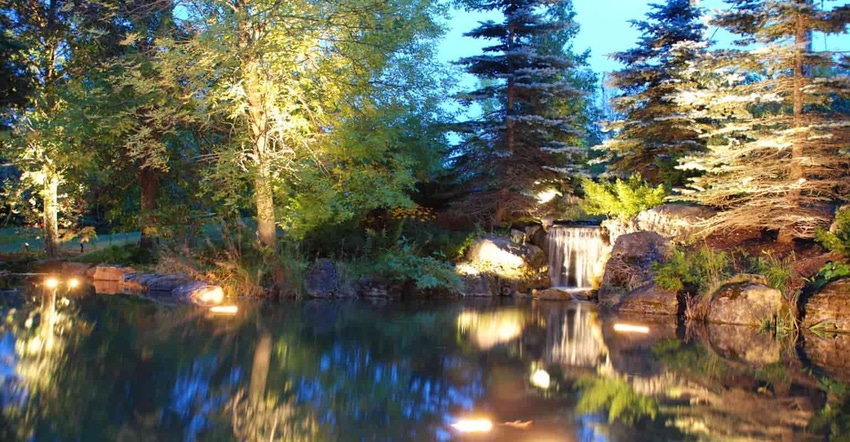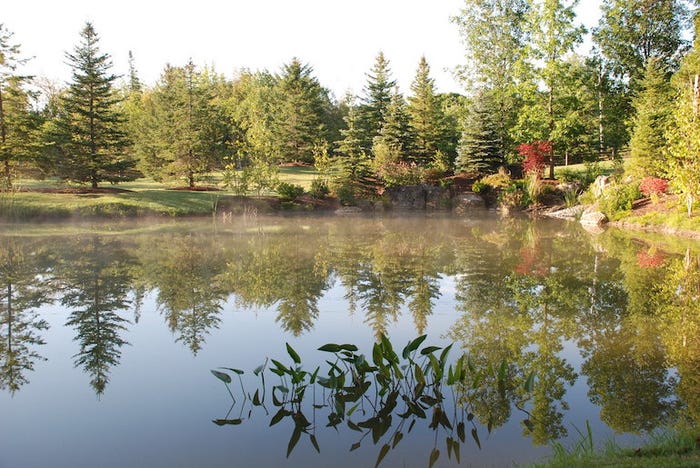Randy Tumber of Tumber International Landscape Training discusses his naturalistic design philosophy, his use of environmentally friendly materials and utilizing water features in his designs.

For this edition of the Fast 5—a Q&A series featuring the insights and expertise of pool and spa industry experts—Randy Tumber, owner of Tumber International Landscape Training, sat down to provide us with some refreshing insights through his design philosophy.
Tell us about your design philosophy, which leans toward naturalistic design. Why has that been your preference?
Tumber: Years ago, when I first got into landscaping, I quickly realized it was a very transient way of doing things. You may remember the red zigzag lock stone of the '70s, the exposed aggregate of the '80s, all the lock stone swirls and circles of the '90s, and so many trends that kept coming and going. I always wanted to be like some of these leading-edge architects until it occurred to me that these aren't cutting-edge ideas. These ideas are driven by the manufacturers who are going to the architect and saying, "Here, use our stuff."
I started to get clients calling to ask if I could come in and rip out all the material that's passe and put in something that isn't going to keep changing with the fads and the trends. It became evident to me that the only thing that will stand the test of time that doesn't constantly get diluted is natural elements—natural stone, natural plant material and natural styles. I had a lot to learn, so I started studying as much as possible about what I could discover in creation, how one thing equates to another and the symbiotic relationships woven throughout the entire ecosystem. I decided that I would create something to stand the test of time and that transcends all of these fads.
From this, I found a niche that appeals to a lot of people. I sacrificed a lot of my workload by going down this naturalistic design path, which was ok with me. I had been down the road of managing a bunch of guys, three construction crews and a maintenance crew, and all I did was run myself ragged. I got more satisfaction pulling it back down to one project at a time, one crew at a time. By doing everything in-house, we're able to have full control of the way things were, so we utilized things like natural stone, wood and water.
"It occurred to me that nobody doesn't love nature."
My business expanded from landscaping design to construction to aquatics to native habitat restoration to natural stonework, which all flowed very nicely together. My mantra now is we make believers one person at a time, which we truly do with each client.
Now, there's a huge movement with everyone trying to save the planet, which is a noble intention, but until you understand how these natural ecosystems function with each other, you can't develop them and build around them. I've tried to do that, and I've tried to stay away from the things that are so linear and square, flat and one-dimensional—chrome, stainless steel, glass. I try to create something natural in approach, appeal and function. We use native plant materials wherever possible; we integrate the water features into them in a very natural way, and we've had a good following as a result.
Can you tell our audience more about how naturalistic design benefits the planet?
Tumber: Something as simple as permeable pavers are a prime example of addressing stormwater management. Let the water percolate down, get filtered through natural processes, and go back to the aquifers and recharge our aquifers because we all want fresh water. It dovetails nicely with everything else we're doing.
We plant things up in such a way that the root system will get well established; it's native, as close to zero maintenance as you're going to get, and we use ground covers and natural mulches. We try to avoid trendy things like black mulch with dye in it where they're using too much recycled wood. We also avoid recycled pallets with potentially hazardous materials that have been spilled on them in warehouses, pressure-treated lumber, decking that's been pulled out and recycled and had a pretty color added into it- the dye puts potential toxins into the gardens.
There's so much hardwood in the pallets that for that to decompose naturally, it takes so much out of the soil and actually short circuits the plant food process because the plants need the decomposing wood and bark in order to provide the micronutrients to survive. We don't want to shortchange the plants, so we use spruce, pine, fir, cedar and hemlock from the local mills, which are ground up; we use the bark and tender wood. We put that on two or three inches thick, providing a natural base for regrowth and insulating the roots from the hot sun, which retains moisture. As it breaks down, it provides micronutrients for the plant food process as well, so we're working in harmony with what we find in creation. That's my big goal. There are many benefits from posing the question of how this natural cycle works and how I can make it so that I fit into it, rather than forcing it to fit me.

How can other designers implement water features in a very natural way where it blends into the backyard living environment?
Tumber: That's another thing that I have narrowed to a very niche market because not everyone likes the old-fashioned kidney-shaped pools or free-form pools—it's not trendy, it's not contemporary, but if you go back to the 1950s and 1960s and look at some of the other pools, it's all trend cycles. I've said I don't want to do that. The square-rectangle looks have their place, and some of the most spectacular water features I've ever seen are ones where they've been designed and built like that. I've seen stuff that takes my breath away, but I can't subscribe to that because I don't know how. I don't have that training. My 40-odd years have been focused on the study of what I see in the natural environment around me and then trying to develop that.
Every client doesn't want that, which I respect. I would never put myself in a place where I would pretend to know how to do that, but what I do know how to do is something that appeals to many people. I try to do whatever I can to ensure that the water feature that's put in actually feels like it belongs. We'll place rocks that we've acquired from the Niagara escarpment with horizontal lines with moss on them; when you place that rock into a waterfall or beside a pool edge or retaining wall or by a fire pit terrace, as soon as its put in there, it looks like it's been there for 10,000 years.
Water naturally erodes the ground, and all the loose material gets washed out until it goes back into the harder ground. Look at Niagara Falls. It's a great big crescent because it has eroded and worked its way back and continues to do so. When you're building a waterfall, have it recess back in, not stand out with this monolithic box with water spewing out of it. It's better if it's cut back in and looks like it has eroded. That allows you to have a river mouth for better presentation and more natural subconscious acceptance. It also allows you to project the acoustics or echo chamber in a certain direction.
Can you tell us more about acoustics and the echo chamber of water?
Tumber: The tuning of water features is a seminar in itself, but there are three distinct sounds in water features—the bong sound, the hissing sound and the babbling brook sound. When you're sitting poolside or sitting on a terrace beside a stream, it's cool if you can have the elevator music in the background—like the hissing sound—so you can have a pleasant conversation in a normal tone of voice.
On the other hand, the bong sound is an irritant. That's the one that makes everyone have to go to the bathroom all the time, so you would project that to an area where you would have a vantage point way far away. The static water level will carry the sound—as you know, on a lake, you can hear people whispering on the shore. You can project that bong sound a long distance, but don't project it toward the area that's intimate. You keep the pleasant sounds close by, especially in a situation with an indoor waterfall.
How can you use waterfalls to your advantage beyond aesthetics?
Tumber: You can use waterfalls to buffer road noise, mitigate objectionable noise and introduce that pleasant sound of flowing water. The sunlight picks up the white water, so you walk in, your eye catches it, then your ear catches it. You have just made a journey that you may not even realize because you just went from visual to emotional—you just appealed to the heart.
Suppose you can evoke an emotional response from what you've designed and constructed and make it functional, realistically maintainable and aesthetically pleasing. In that case, I believe you've accomplished the goal that you've planted in your clients' hearts. Of course, not everyone wants to go there, but for those who do, I derive a great amount of pleasure in providing that for them and making believers one client at a time.
Read more about:
sustainabilityAbout the Author(s)
You May Also Like




